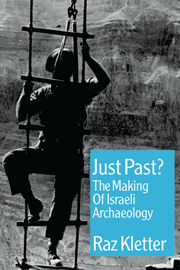Book contents
- Frontmatter
- Dedication
- Contents
- List of illustrations
- Introduction
- Acknowledgements
- Abbreviations
- 1 Archaeology and the 1948 War
- 2 Abandoned places, new places
- 3 Foreign aid
- 4 Frozen funds
- 5 A battalion of guards
- 6 Relief work
- 7 Man robs his land: “agreement” with General Dayan
- 8 “Gold of Ophir for Beth-Horon”: 3,000 shekels
- 9 The building beyond the border: the PAM, 1948–67
- 10 A building of dreams: a home for the IDAM and the origins of the Israel Museum, Jerusalem
- 11 A dead man on the council: the story of the supreme archaeological body in Israel
- 12 “But trust comes from the heart”: travels with the Government Tourist Corporation
- 13 “Whether in a courtyard of a synagogue, in a courtyard adjacent to a synagogue, or under a synagogue”: the Safad affair
- 14 The policy of salvage and early Israeli excavations
- 15 Myths and conclusions
- Appendix: other documents from the IDAM files
- Bibliography
- Author index
- Index
1 - Archaeology and the 1948 War
- Frontmatter
- Dedication
- Contents
- List of illustrations
- Introduction
- Acknowledgements
- Abbreviations
- 1 Archaeology and the 1948 War
- 2 Abandoned places, new places
- 3 Foreign aid
- 4 Frozen funds
- 5 A battalion of guards
- 6 Relief work
- 7 Man robs his land: “agreement” with General Dayan
- 8 “Gold of Ophir for Beth-Horon”: 3,000 shekels
- 9 The building beyond the border: the PAM, 1948–67
- 10 A building of dreams: a home for the IDAM and the origins of the Israel Museum, Jerusalem
- 11 A dead man on the council: the story of the supreme archaeological body in Israel
- 12 “But trust comes from the heart”: travels with the Government Tourist Corporation
- 13 “Whether in a courtyard of a synagogue, in a courtyard adjacent to a synagogue, or under a synagogue”: the Safad affair
- 14 The policy of salvage and early Israeli excavations
- 15 Myths and conclusions
- Appendix: other documents from the IDAM files
- Bibliography
- Author index
- Index
Summary
In the middle of the excavation area, a camouflaged evacuation post for the wounded
(GL44875/9)It is easy to be dead.
Charles Sorely (c.1917)GROUND ZERO
On 16 December 1947, senior Hebrew archaeologists met to discuss the place of archaeology in the future Hebrew state. They included professors at the Hebrew University Leo Ari Mayer and Eliezer Lipa Sukenik; the Committee of the Israel Exploration Society (IES) Itzhak Ben-Zvi (later President of Israel), Moshe Schwabe, Itzhak Ernst Nebenzahl (State Comptroller of Israel, 1961–81), Binyamin Mazar, Haim Zeev Hirschberg, Avraham Bergman and Shemuel Yeivin (Yeivin was also chief translator of the Mandatory government: GL44869/1, letters dated 4.7.48, 22.9.48); and members of the Mandatory Department of Antiquities Immanuel Ben-Dor, Michael Avi-Yonah, Pinhas Penuel Kahane and Ruth Kallner (later Amiran). Two other dignitaries, Moshe Stekelis and Bruno Kirschner, could not attend the meeting. In this hectic period (Pilowsky 1988), all the participants still believed that the Rockefeller Museum must remain united, and most of them thought that the Hebrew state should erect its own department of antiquities that would protect ancient places (which were an “immeasurable national asset”), carry out and license excavations, supervise museums, make a general survey, develop large-scale research and “enter the idea of saving ancient assets and their study into the hearts of the people” (GL44868/7, report by Mayer 8.1.48). They recommended a department with two sections: a central office headed by a director and deputy director and a network of supervisors.
- Type
- Chapter
- Information
- Just Past?The Making of Israeli Archaeology, pp. 1 - 41Publisher: Acumen PublishingPrint publication year: 2006



